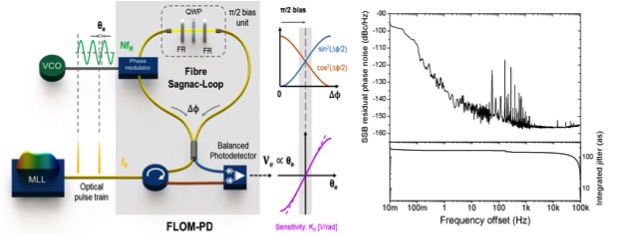
|
 |
 |
 |
 |
 |
 |
 |
 |

|
Femtosecond Laser-based Microwave Photonics
Femtosecond passively mode-locked lasers can be a useful optical source for various microwave photonic applications by coherently linking optical frequencies and microwave frequencies. The application area spans wide, including ultralow-noise microwave generation, remote microwave phase transfer, photonic radars, and RF signal processing. In the last few years, we have pioneered low-noise mode-locked laser-based microwave photonics field.
The first research topic is precise, accurate and long-term-stable phase detection between optical pulse train and RF/microwave signal. We developed a method, named the fiber-loop optical-microwave phase detector (FLOM-PD), that can suppress both high-frequency residual phase noise and long-term phase drift: the demonstrated residual phase noise performance is -159 dBc/Hz with sub-fs long-term stability [1] (see Fig 1). Note that, due to its simple structure and excellent performance, the FLOM-PD has already been widely used by many other groups for microwave signal synthesis, time-frequency distribution, laser frequency stabilization, microwave read-out from optical atomic clocks, laser-microwave synchronization for ultrafast X-ray and electron sources, and fiber strain sensing.

[FLOM-PD structure and the residual phase noise spectrum at 10-GHz]
The second research topic is all-fiber-photonic, ultralow-phase-noise microwave generators. By combining the ultralow-jitter mode-locked Er-fiber laser and the FLOM-PD-based laser-microwave synchronization, we demonstrated a compact, ultralow-phase-noise 10-GHz microwave signal generator with -142 dBc/Hz phase noise at 10-kHz Fourier frequency and sub-500-attosecond jitter (integration bandwidth: 10 kHz - 10 MHz) [2]. In order to further suppress the repetition-rate phase noise in the lower Fourier frequency range, we also developed an all-fiber Michelson interferometer-based repetition-rate stabilization method [3], which features low cost and simple design. The resulting integrated absolute timing jitter is only 3.0 fs over 0.1 s, and the equivalent phase noise is comparable to or even lower than state-of-the-art room- temperature microwave oscillators.
Final topic of interest is the remote phase transfer of microwave signals using optical frequency combs. Using the FLOM-PD technology, we demonstrated a new method of transferring microwave phase over kilometer-scale fiber links with unprecedented 10-19-level relative frequency instability [4,5]. We also achieved attosecond-stability, 100-m-long free-space timing transfer, which is useful for timing transport in accelerator facilities [6].
Our mode-locked laser-based microwave photonics works have been recognized by many invited talks at high-quality international conferences including IEEE International Topical Meeting on Microwave Photonics (IEEE-MWP) 2015, Asia Communications and Photonics Conference (ACP) 2015, Optical Fiber Sensors (OFS) 2017, and Progress in Electromagnetics Research Symposium (PIERS) 2017. In 2016 we published an invited paper that comprehensively reviews our microwave photonics works at Journal of Lightwave Technology [7]. We are currently expanding our unique mode-locked laser-based microwave photonics research field into (a) free-space communication, (b) ultra-sensitive strain and acoustic sensors [8], (c) extraction of ultralow-jitter digital clock signals directly from mode-locked lasers, and (d) on-chip and chip-to-chip clock distribution networks.
Related Publications
[1] K. Jung and J. Kim, "Subfemtosecond synchronization of microwave oscillators with mode-locked Er-fiber lasers," Opt. Lett. 37, 2958 (2012)
[2] K. Jung, J. Shin, and J. Kim, "Ultralow phase noise microwave generation from mode-locked Er-fiber lasers with subfemtosecond integrated timing jitter," IEEE Photonics J. 5, 5500906 (2013)
[3] K. Jung and J. Kim, "All-fibre photonic signal generator for attosecond timing and ultralow-noise microwave," Sci. Rep. 5, 16250 (2015)
[4] K. Jung, J. Shin, J. Kang, S. Hunziker, C. K. Min, and J. Kim, "Frequency comb-based microwave transfer over fiber with 7x10-19 instability using fiber-loop optical-microwave phase detectors," Opt. Lett. 39, 1577 (2014)
[5] K. Jung, J. Lim, J. Shin, H. Yang, L. Chen, F. X. Kaertner, H. Kang, C. Min, and J. Kim, "Remote Laser-Microwave Synchronization Over Kilometer-Scale Fiber Link With Few-Femtosecond Drift," J. Lightwave Tech. 32, 3742 (2014)
[6] J. Kang, J. Shin, C. Kim, K. Jung, S. Park, and J. Kim, "Few-femtosecond-resolution characterization and suppression of excess timing jitter and drift in indoor atmospheric frequency comb transfer," Opt. Express 22, 26023 (2014)
[7] J. Kim, K. Jung, J. Shin, C. Jeon, D. Kwon, "(Invited) Femtosecond laser-based microwave signal generation and distribution," J. Lightw. Tech. 34, 4631 (2016)
[8] X. Lu, S. Zhang, X. Chen, D. Kwon, C. Jeon, Z. Zhang, J. Kim, and K. Shi, "Ultrasensitive, high-dynamic-range and broadband strain sensing by time-of-flight detection with femtosecond-laser frequency combs," Sci. Rep. 7, 13305 (2017) 
|
|
|
 |
|


